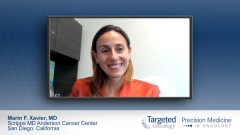
Classifying and Stratifying Patients With DLBCL
A review of the criteria that help hematologist-oncologists appropriately manage patients with diffuse large B-cell lymphoma.
Episodes in this series

Marin F. Xavier, MD: Hello, and thank you for joining this Targeted Oncology™ presentation titled “CD19 as a Target in the Treatment of Diffuse Large B-cell Lymphoma.” Patients with newly diagnosed diffuse large B-cell lymphoma have relatively limited treatment options. R-CHOP [rituximab, cyclophosphamide, hydroxydaunorubicin hydrochloride, vincristine, prednisone] has been the standard of care for many years, but up to 50% of patients will relapse and are not cured by that regimen alone. CD19 has recently emerged as a very promising treatment therapeutic target, especially in the relapsed setting. CAR [chimeric antigen receptor] T cells] T cells and monoclonal antibodies targeting CD19 are being tested in treating patients in the relapsed/refractory and frontline settings. In today’s discussion on precision medicine in oncology, we’ll talk about the role of CD19 in the targeted treatment of patients with diffuse large B-cell lymphoma [DLBCL].
I’m Dr Marin Xavier, a hematologist-oncologist from Scripps MD Anderson Cancer Center [in San Diego, California]. Joining me is my colleague Dr John Burke, a hematologist-oncologist from Rocky Mountain Cancer Centers [in Aurora, Colorado]. Thank you for joining us. Let’s begin.
Dr Burke, I don’t know if you want to add to any of that, but we should start with an overview about diffuse large B-cell lymphoma to set the stage about the frontline setting and patients: how they typically present to you in the clinic or the hospital. Then we can talk about different subtypes, patients who may be higher risk and require something other than R-CHOP [rituximab, cyclophosphamide, hydroxydaunorubicin hydrochloride, vincristine, prednisone], and so on. Would you like to talk a little about the disease space and presentation?
John M. Burke, MD: Typically, when patients present with large cell lymphoma, most oncologists know they usually present with enlargement of a lymph node. Other constitutional symptoms may include fevers, fatigue, weight loss, and even drenching night sweats. Sometimes if there’s involvement of an organ, there can be pain. For example, bone involvement can be painful and lead to pathological fractures. Things like pulmonary involvement could present as a pleural effusion, and of course, brain involvement could present as seizures, change in mental status, or focal weakness. DLBCL can present anywhere, but the most common thing I see is lymphadenopathy.
Marin F. Xavier, MD: Oftentimes patients present with obstructive symptoms organ dysfunction. The tricky thing from a clinical standpoint is determining if R-CHOP [rituximab, cyclophosphamide, hydroxydaunorubicin hydrochloride, vincristine, prednisone] is sufficient or if they’re in a high-risk category. I teach my fellows and residents that in most patients, R-CHOP [rituximab, cyclophosphamide, hydroxydaunorubicin hydrochloride, vincristine, prednisone] is adequate, unless they have double or triple hit, HIV, or primary mediastinal lymphoma. In that case we would do a dose-adjusted R-EPOCH [rituximab, etoposide, prednisone, vincristine, cyclophosphamide, hydroxydaunorubicin hydrochloride]. Would you agree, John?
John M. Burke, MD: Yes, I generally do the same thing for primary mediastinal tumors.
Marin F. Xavier, MD: An area with a lack of consensus is CNS [central nervous system] disease prophylaxis and risk stratification. We do have a CNS international prognostic index, and for patients who have very high-risk scores, they can have up to 10% risk of CNS involvement. You have to integrate. We recommend, in fit enough patients, incorporating systemic methotrexate, medium to high dose, or intrathecal chemotherapies—or both or neither. That’s the 1 area where—even after coming back from our most recent lymphoma conference—I have more questions than answers.
John M. Burke, MD: Totally agree. It’s really controversial. I’ve been doing this long enough that for many years it was always just intrathecal methotrexate, and then the limitations of that became recognized. Investigators started trying systemic methotrexate in various ways, mixing it between cycles of R-CHOP [rituximab, cyclophosphamide, hydroxydaunorubicin hydrochloride, vincristine, prednisone] or delivering it at the end. Even at the most recent ASH [American Society of Hematology Annual Meeting], data coming out suggested that no matter what you do, it may not be working that well. It’s a tough area with more questions than answers, and it’s tough to know. I still do it for the high-risk patients or offer it and recommend it for the high-risk patients, but I definitely have uncertainty as to how much I’m helping.
Marin F. Xavier, MD: Some people believe you’re just delaying their CNS progression and not curing any more additional patients.
Transcript edited for clarity.








































